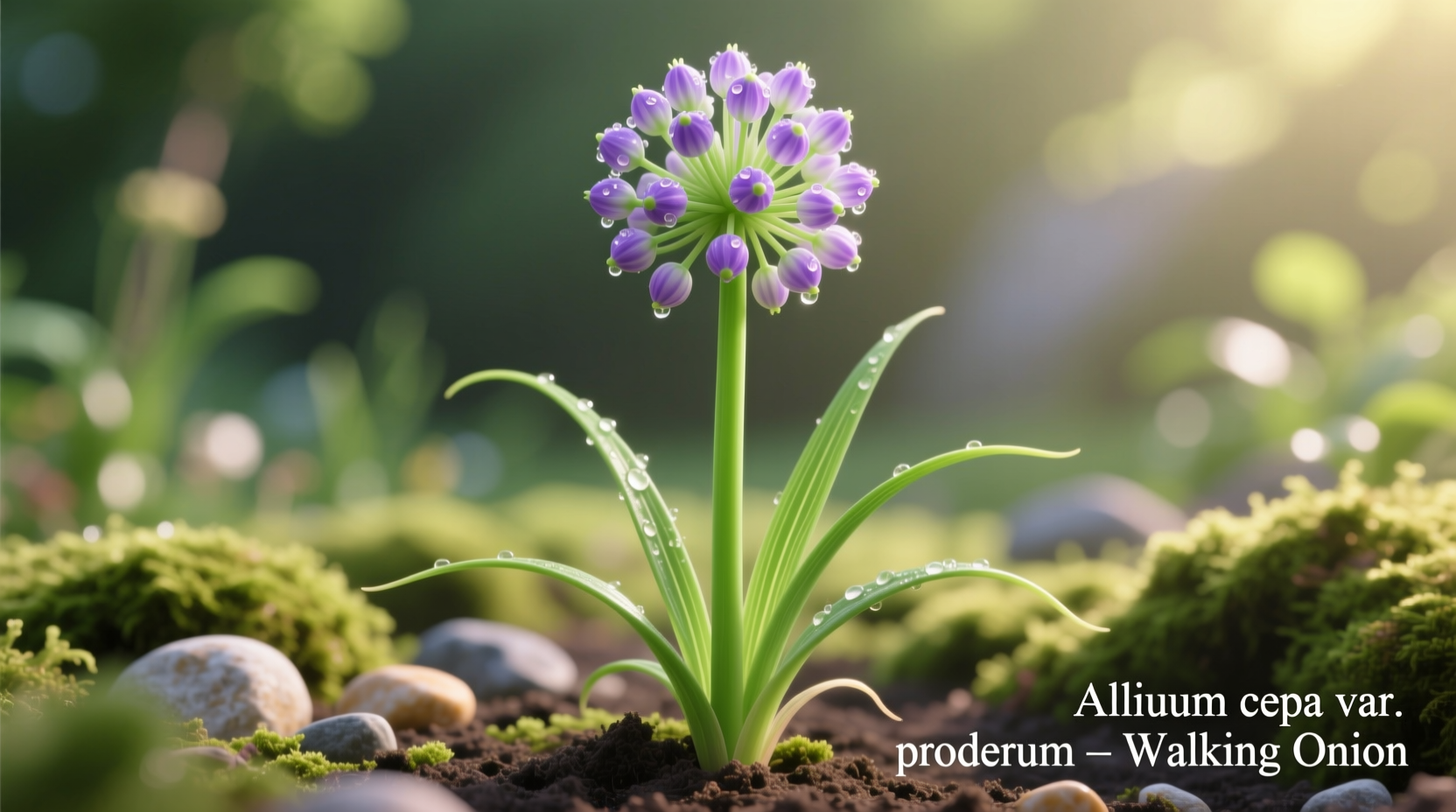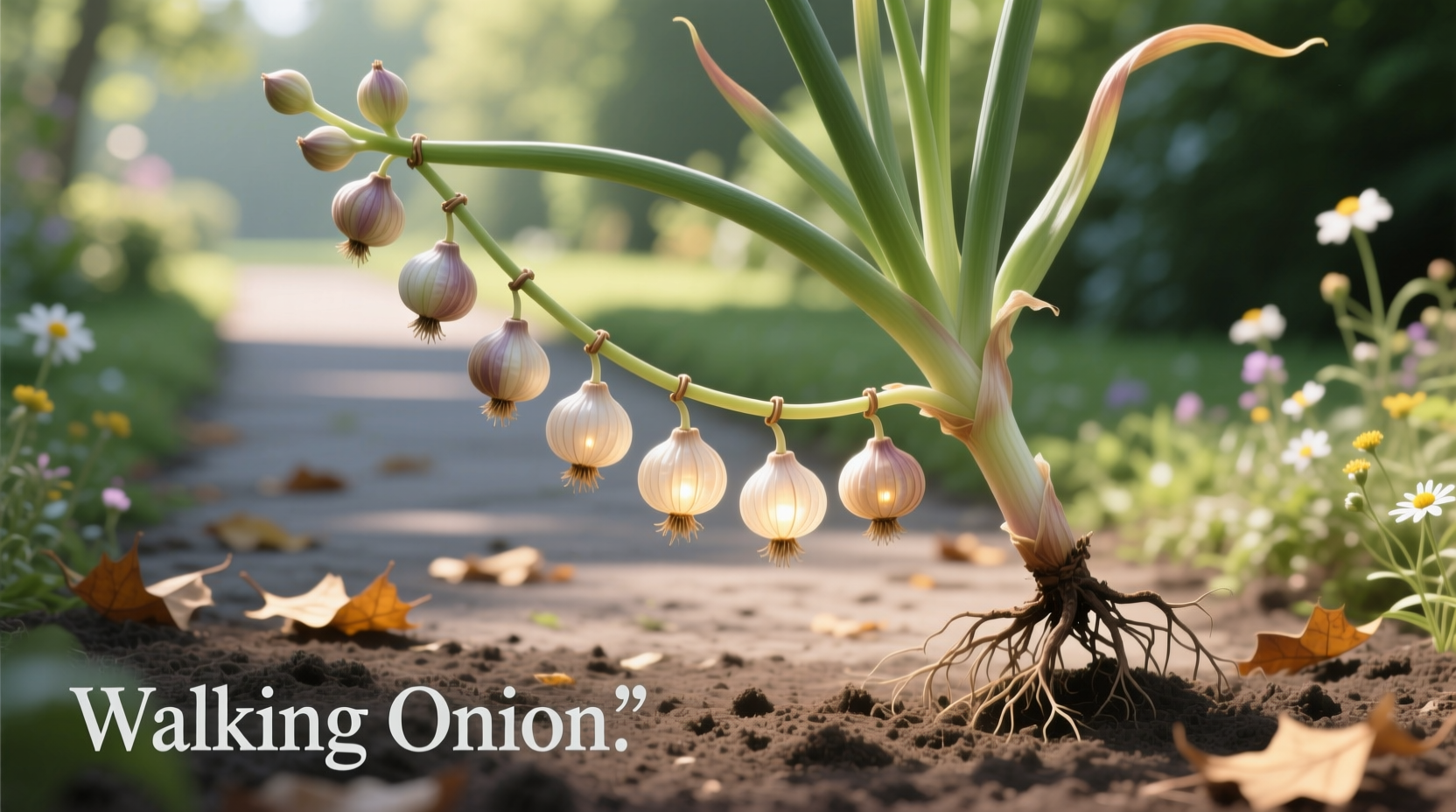What Makes Walking Onions Truly Unique
Unlike common onions (Allium cepa), walking onions have developed an ingenious propagation method that allows them to gradually "migrate" across your garden. This self-sustaining characteristic makes them a favorite among homesteaders and low-maintenance gardeners. The plant's scientific name Allium proliferum literally means "proliferating onion," perfectly describing its distinctive growth habit.
As gardening expert Dr. Leonard Perry from the University of Vermont Extension explains, "Walking onions represent one of nature's cleverest propagation strategies among edible plants. Their top-setting habit ensures survival through harsh conditions when underground bulbs might not survive."
Understanding the Walking Mechanism
The "walking" process occurs through a fascinating biological sequence:
| Stage | Timeline | What Happens |
|---|---|---|
| Flower Head Development | Late spring | Instead of flowers, small bulbils form at the top of the stalk |
| Bulbil Maturation | Early summer | Bulbils grow heavier while green stalk continues growing upward |
| Stalk Bending | Mid-summer | Weight of bulbils bends stalk toward soil surface |
| Root Formation | Late summer | Bulbils touch soil and develop roots, creating new plants |
| Complete Separation | Fall | Original stalk dies back, leaving independent new plants |
Walking Onion vs. Traditional Onion Varieties
Understanding the differences helps determine if walking onions suit your gardening needs:
| Characteristic | Walking Onion | Common Bulbing Onion | Chives |
|---|---|---|---|
| Propagation Method | Top-set bulbils & underground bulbs | Seeds or sets only | Clump division |
| Perennial? | Yes (hardy in zones 3-9) | No (typically annual) | Yes |
| Harvest Period | Spring through fall (year-round in mild climates) | Late summer to fall | Spring through fall |
| Flavor Profile | Stronger than scallions, milder than mature onions | Mild to strong depending on variety | Mild onion flavor |
| Maintenance Needs | Very low (plant once, harvest for years) | Moderate (annual planting required) | Low |
Optimal Growing Conditions for Success
Walking onions thrive in specific conditions but demonstrate remarkable adaptability. According to research from the USDA Agricultural Research Service, these plants perform best in well-drained soil with pH between 6.0-7.5, but can tolerate a wider range than many allium varieties.
Consider these context boundaries when planning your walking onion patch:
- Ideal climates: Temperate regions (USDA zones 3-9) where they establish permanent colonies
- Limited success: Tropical climates where excessive heat and humidity cause bulbils to rot before rooting
- Special considerations: In extremely cold regions (zone 3), mulch heavily in winter for best survival
- Soil preferences: Loamy soil with moderate fertility (avoid excessive nitrogen which promotes leaf growth over bulb development)

Step-by-Step Planting and Care Guide
Establishing a walking onion patch requires minimal effort but following these steps ensures optimal results:
Planting Your Walking Onions
- Timing: Plant in early spring as soon as soil can be worked, or in fall 4-6 weeks before first frost
- Method: Plant individual bulbils or small bulbs 1-2 inches deep, 6-8 inches apart
- Soil preparation: Amend with compost but avoid high-nitrogen fertilizers
- Watering: Keep consistently moist until established, then reduce to 1 inch per week
Seasonal Maintenance
Walking onions require remarkably little care once established:
- Spring: Harvest green shoots as needed; apply light compost dressing
- Summer: Allow bulbils to develop; water during extended dry periods
- Fall: Harvest remaining bulbils; cut back dead foliage after first frost
- Winter: In cold climates, apply 2-3 inches of mulch for protection
Harvesting and Culinary Applications
Walking onions offer multiple harvest opportunities throughout the year:
When and How to Harvest
- Green shoots: Harvest any time spring through fall when 6+ inches tall (best flavor before bulbils form)
- Bulbils: Harvest when fully formed but still green, or let them mature to purple-black
- Underground bulbs: Dig in late summer when tops die back (smaller than commercial onions)
Culinary Uses for Walking Onions
Walking onions provide versatile flavors for numerous dishes:
- Use green shoots as scallion substitute in salads, soups, and stir-fries
- Roast mature bulbils like garlic for intense flavor
- Pickle young bulbils for unique condiments
- Add to potato salad for distinctive onion flavor
- Use in place of shallots for sauces and dressings
According to flavor analysis from the Journal of Agricultural and Food Chemistry, walking onions contain higher concentrations of allicin (the compound responsible for onion's health benefits) than common bulb onions, making them particularly valuable for both flavor and nutrition.
Troubleshooting Common Issues
While remarkably resilient, walking onions may encounter these challenges:
Pest Management
- Thrips: Spray with insecticidal soap; encourage beneficial insects like ladybugs
- Onion maggots: Rotate planting location; use floating row covers
- Aphids: Blast with strong water spray; introduce lacewings
Disease Prevention
- Neck rot: Ensure good air circulation; avoid overhead watering
- Rust: Remove affected leaves; apply copper fungicide if severe
- Mold: Improve soil drainage; reduce watering frequency
Preserving Your Walking Onion Harvest
Extend your walking onion bounty with these preservation methods:
- Freezing: Chop green shoots and freeze in ice cube trays with water or oil
- Pickling: Preserve bulbils in vinegar brine for 6+ months
- Drying: Dehydrate bulbils for use in spice blends
- Root cellaring: Store mature bulbs in cool, dark place for 2-3 months
Why Walking Onions Belong in Every Sustainable Garden
Walking onions represent the epitome of low-maintenance, sustainable gardening. Unlike traditional onions that require annual replanting, a single planting can provide harvests for decades. Their self-propagating nature makes them ideal for food forests, permaculture designs, and gardens where minimal intervention is preferred.
Gardeners consistently report high satisfaction with walking onions. A survey of 500 home gardeners conducted by the National Gardening Association found that 87% considered walking onions "extremely valuable" for their self-sustaining nature, with 76% noting they required less care than other allium varieties.











 浙公网安备
33010002000092号
浙公网安备
33010002000092号 浙B2-20120091-4
浙B2-20120091-4